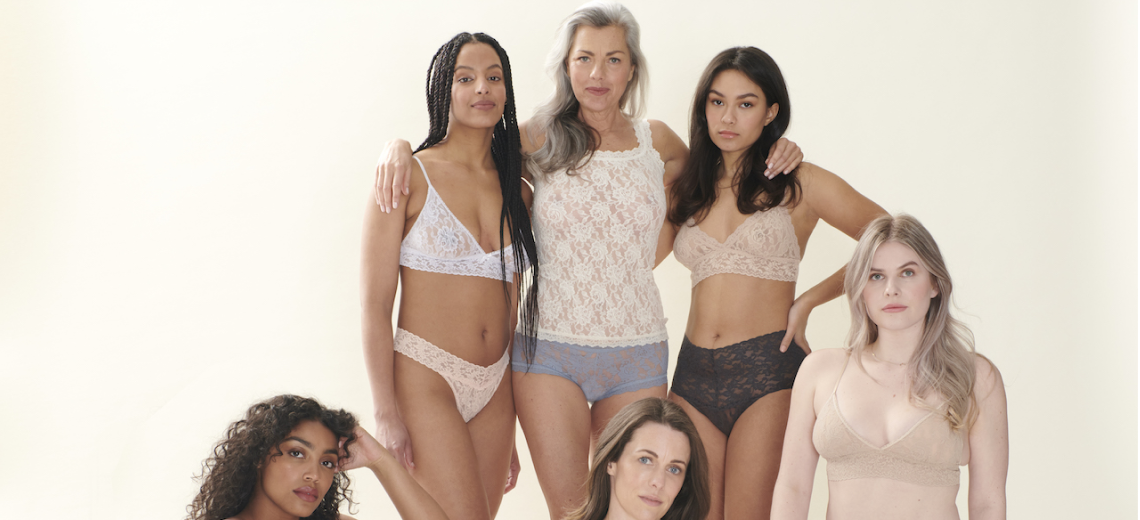In the last year, many fashion brands transformed: some switched entirely to DTC, others put more emphasis on e-commerce and companies also closed stores entirely.
In light of all these changes, many in the fashion world have decided to reintroduce themselves.
In the last few months, brands like Hanky Panky and Victoria’s Secret, fashion platforms like LTK (formerly known as LikeToKnowIt and rewardStyle) and retailers like Neiman Marcus have all found ways to change up their imagery, logos, messaging or product to better reflect the world we live in now.
Hanky Panky, a 44-year-old underwear brand, is launching its rebrand today, with a new logo, new messaging around comfort and a collection of four versions of its signature 4811 thong (each is styled after one of the four decades the brand has existed: ’80s, ’90s, ’00s and ’10s). While much of the rebrand was about reaffirming the brand’s pillars — comfortable lingerie that is sexy but not objectifying — other elements were more practical.
“The reality is that our old logo was designed before the website was a platform for selling and before social media,” said Hanky Panky CEO Brenda Berger. “We had this stacked logo that just was not the most digital-friendly, so we focused on keeping the same feeling but updating it for the new platforms we use.”
The new logo is softer, with thinner strokes in the typeface and the Y’s have been reshaped to call to mind its signature thong.

Hanky Panky’s refresh is also meant to emphasize the brand’s diversity and inclusion efforts. While Berger said the brand has always done a good job of hiring models in a diversity of sizes, the new collection includes a greater focus on race and age as well.
“It’s about showing people being comfortable in our intimates, rather than something very staged with traditional models,” Berger said.
Another intimates brand, Cosabella, rebranded at the beginning of August for the first time in its 40 year history. The traditional pink logo with a bow was replaced with a clean black and white iteration to reflect the brand’s move away from gender-specific products. As part of the refresh, Cosabella’s lingerie won’t be exclusive to women and is marketed now to all genders.

For Cosabella CEO Guido Campello, the rebrand is a culmination of what the compamu has been building towards for years.
“Since this brand was founded, we’ve had a history of challenging the industry to cater to different bodies and remove the barriers for self-expression associated with body image, sexual identity, gender and age,” Campello said. “After four decades, we’ve organically evolved past thinking about women’s wear and have finally reached the point of progress as a society. It’s a beautiful time.”
5 Questions: Neiman Marcus CMO Daz McColl on its newest campaign
Neiman Marcus is also in the midst of a refresh. On August 9, the department store rolled out its latest campaign, “Re-Introduce Yourself.” On August 19th, Neiman Marcus will launch a short video spot to digital and streaming TV channels about emerging from the last year.
CMO Daz McColl said the subtext of the campaign is also about reintroducing Neiman Marcus to its customers after a long period of reduced foot traffic. Here, McColl talks a bit more about the inspiration behind the campaign and how it was created.
What led you to this campaign?
“We’re reintroducing ourselves to the customer at a time when a lot of people have changed. They’re coming out of the depression of the last year, so it’s an opportunity for them to reintroduce themselves to the world and for us to reintroduce ourselves to them.
Our big insight was that the last year really affected how people think about fashion. The positive side of being locked up for so long is that we can change emerge differently. People are thinking ‘What do I wear to work now that I’m only going three days a week?’ Maybe you dress up more since you’re going in less frequently. I had a friend tell me they never thought they’d go back to wearing heels so quickly.”
Was the campaign produced differently?
“We shot on two locations: at one of our stores in New Jersey and at a mansion on Long Island. The safety protocols were in place obviously, but we could have our directors on set. We tried to conceive and plan the campaign the same way we always do, in terms of process, and then figure out how to execute around the safety protocols.”
Is the content different in any notable way?
“We always want to hold onto things like our elevation of style and making sure everything looks luxurious, but we also did things a little differently. The relationship between the customer and the style advisor is highlighted in the campaign. Most marketing focuses on product, and we do that too, but for this campaign, we wanted to focus on that relationship.”
Do you feel like you can be bolder or more frank with customers?
“I’ve only been with the company since January of last year, so my legacy is a bit limited, but prior to that Neiman Marcus has always been very authentic. Now there is the ability to be a bit more open. You can say ‘Hey, it hasn’t been great over the last year’ and then try and turn that into something positive.”
You’re launching this campaign on connected TV; what is that experience like?
“We don’t necessarily compare channels as which one is better than another, it all depends on their role. We’re very data-driven, and connected TV is great because it’s all about targeting. We’re not a brand that is for everyone and we recognize that. So, it’s a great channel because we can target very specific customers that we think would like us.”
Reading List
Inside our coverage
Virtual fitting and size-inclusive brands are a perfect match.
Sephora’s partnership with Kohl’s proves big retailers only want to be bigger.
Trucker hats are back in fashion.
What we’re reading
What will it take to break into China’s sneaker resale market?
Mending is the next movement in sustainable fashion.
What happens now to all those “Cuomosexual” tees?
Photo credit: Hanky Panky




